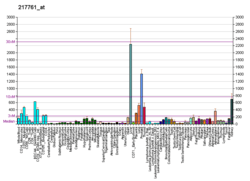ADI1
The human ADI1 gene encodes the enzyme 1,2-dihydroxy-3-keto-5-methylthiopentene dioxygenase.[5][6][7]
Function
The enzyme belongs to the aci-reductone dioxygenase family of metal-binding enzymes, which are involved in methionine salvage. This enzyme may regulate mRNA processing in the nucleus, and may carry out different functions depending on its localization.
Clinical significance
Diseases associated with ADI1 include Klebsiella, and refsum disease.
ADI1 is capable for supporting hepatitis C virus replication in an otherwise non-permissive cell line.[8] Mouse hepatoma cells coexpressing human CD81 and ADI1/Sip-L supported HCV infection and replication.[9] Human ADI1//Sip-L over-expression in 293 cells enhances cell entry but not replication of HCV.[10][11]
References
- 1 2 3 ENSG00000182551 GRCh38: Ensembl release 89: ENSG00000280830, ENSG00000182551 - Ensembl, May 2017
- 1 2 3 GRCm38: Ensembl release 89: ENSMUSG00000020629 - Ensembl, May 2017
- ↑ "Human PubMed Reference:".
- ↑ "Mouse PubMed Reference:".
- ↑ Uekita T, Gotoh I, Kinoshita T, Itoh Y, Sato H, Shiomi T, Okada Y, Seiki M (Mar 2004). "Membrane-type 1 matrix metalloproteinase cytoplasmic tail-binding protein-1 is a new member of the Cupin superfamily. A possible multifunctional protein acting as an invasion suppressor down-regulated in tumors". J Biol Chem. 279 (13): 12734–43. doi:10.1074/jbc.M309957200. PMID 14718544.
- ↑ Hirano W, Gotoh I, Uekita T, Seiki M (Jun 2005). "Membrane-type 1 matrix metalloproteinase cytoplasmic tail binding protein-1 (MTCBP-1) acts as an eukaryotic aci-reductone dioxygenase (ARD) in the methionine salvage pathway". Genes Cells. 10 (6): 565–74. doi:10.1111/j.1365-2443.2005.00859.x. PMID 15938715.
- ↑ "Entrez Gene: ADI1 acireductone dioxygenase 1".
- ↑ Yeh CT, Lai HY, Chen TC, Chu CM, Liaw YF (2001). "Identification of a hepatic factor capable of supporting hepatitis C virus replication in a nonpermissive cell line". J. Virol. 75 (22): 11017–24. doi:10.1128/JVI.75.22.11017-11024.2001. PMC 114682. PMID 11602742.
- ↑ Yeh CT, Lai HY, Yeh YJ, Cheng JC (2008). "Hepatitis C virus infection in mouse hepatoma cells co-expressing human CD81 and Sip-L". Biochem Biophys Res Commun. 372 (1): 157–61. doi:10.1016/j.bbrc.2008.05.018. PMID 18474223.
- ↑ Cheng JC, Yeh YJ, Pai LM, Chang ML, Yeh CT (2009). "293 cells over-expressing human ADI1 and CD81 are permissive for serum-derived hepatitis C virus infection". J. Med. Virol. 81 (9): 1560–8. doi:10.1002/jmv.21495. PMID 19626614.
- ↑ Hwang DR, Lai HY, Chang ML, Hsu JT, Yeh CT (2005). "Emergence of mutation clusters in the HCV genome during sequential viral passages in Sip-L expressing cells". J Virol Methods. 129 (2): 170–7. doi:10.1016/j.jviromet.2005.05.026. PMID 16005986.
External links
- Human ADI1 genome location and ADI1 gene details page in the UCSC Genome Browser.
Further reading
- Maruyama K, Sugano S (1994). "Oligo-capping: a simple method to replace the cap structure of eukaryotic mRNAs with oligoribonucleotides". Gene. 138 (1–2): 171–4. doi:10.1016/0378-1119(94)90802-8. PMID 8125298.
- Suzuki Y, Yoshitomo-Nakagawa K, Maruyama K, Suyama A, Sugano S (1997). "Construction and characterization of a full length-enriched and a 5'-end-enriched cDNA library". Gene. 200 (1–2): 149–56. doi:10.1016/S0378-1119(97)00411-3. PMID 9373149.
- Yeh CT, Lai HY, Chen TC, Chu CM, Liaw YF (2001). "Identification of a hepatic factor capable of supporting hepatitis C virus replication in a nonpermissive cell line". J. Virol. 75 (22): 11017–24. doi:10.1128/JVI.75.22.11017-11024.2001. PMC 114682. PMID 11602742.
- Yamada S, Ohira M, Horie H, Ando K, Takayasu H, Suzuki Y, Sugano S, Hirata T, Goto T, Matsunaga T, Hiyama E, Hayashi Y, Ando H, Suita S, Kaneko M, Sasaki F, Hashizume K, Ohnuma N, Nakagawara A (2004). "Expression profiling and differential screening between hepatoblastomas and the corresponding normal livers: identification of high expression of the PLK1 oncogene as a poor-prognostic indicator of hepatoblastomas". Oncogene. 23 (35): 5901–11. doi:10.1038/sj.onc.1207782. PMID 15221005.
- Gotoh I, Uekita T, Seiki M (2007). "Regulated nucleo-cytoplasmic shuttling of human aci-reductone dioxygenase (hADI1) and its potential role in mRNA processing". Genes Cells. 12 (1): 105–17. doi:10.1111/j.1365-2443.2006.01035.x. PMID 17212658.
- Ewing RM, Chu P, Elisma F, Li H, Taylor P, Climie S, McBroom-Cerajewski L, Robinson MD, O'Connor L, Li M, Taylor R, Dharsee M, Ho Y, Heilbut A, Moore L, Zhang S, Ornatsky O, Bukhman YV, Ethier M, Sheng Y, Vasilescu J, Abu-Farha M, Lambert JP, Duewel HS, Stewart II, Kuehl B, Hogue K, Colwill K, Gladwish K, Muskat B, Kinach R, Adams SL, Moran MF, Morin GB, Topaloglou T, Figeys D (2007). "Large-scale mapping of human protein-protein interactions by mass spectrometry". Mol. Syst. Biol. 3 (1): 89. doi:10.1038/msb4100134. PMC 1847948. PMID 17353931.
- Oram SW, Ai J, Pagani GM, Hitchens MR, Stern JA, Eggener S, Pins M, Xiao W, Cai X, Haleem R, Jiang F, Pochapsky TC, Hedstrom L, Wang Z (2007). "Expression and function of the human androgen-responsive gene ADI1 in prostate cancer". Neoplasia. 9 (8): 643–51. doi:10.1593/neo.07415. PMC 1950434. PMID 17786183.
This article is issued from
Wikipedia.
The text is licensed under Creative Commons - Attribution - Sharealike.
Additional terms may apply for the media files.




